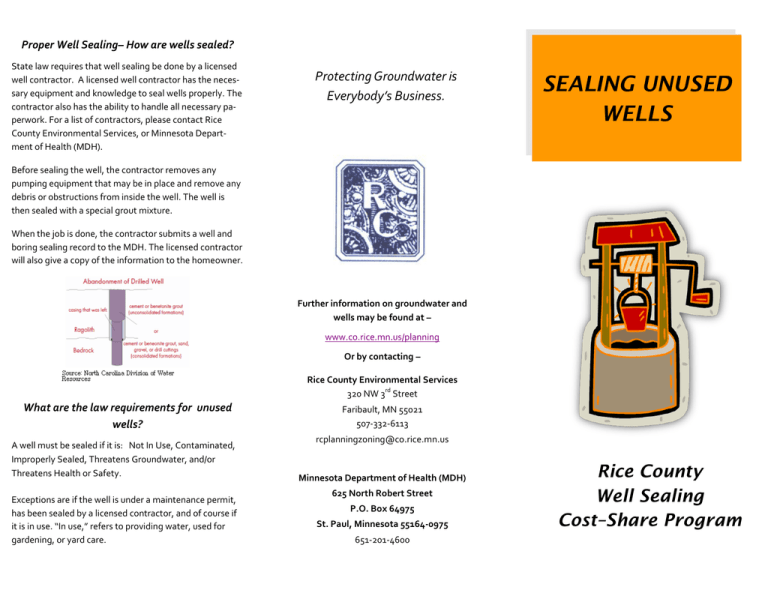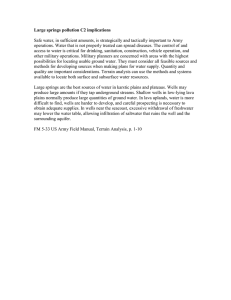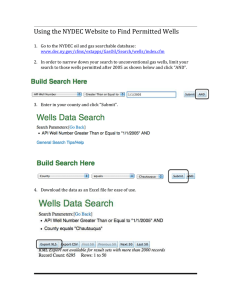Sealing Abandoned Wells Cost-Share Program
advertisement

Proper Well Sealing– How are wells sealed? State law requires that well sealing be done by a licensed well contractor. A licensed well contractor has the necessary equipment and knowledge to seal wells properly. The contractor also has the ability to handle all necessary paperwork. For a list of contractors, please contact Rice County Environmental Services, or Minnesota Department of Health (MDH). Protecting Groundwater is Everybody’s Business. SEALING UNUSED WELLS Before sealing the well, the contractor removes any pumping equipment that may be in place and remove any debris or obstructions from inside the well. The well is then sealed with a special grout mixture. When the job is done, the contractor submits a well and boring sealing record to the MDH. The licensed contractor will also give a copy of the information to the homeowner. Further information on groundwater and wells may be found at – www.co.rice.mn.us/planning Or by contacting – Rice County Environmental Services 320 NW 3rd Street What are the law requirements for unused wells? A well must be sealed if it is: Not In Use, Contaminated, Improperly Sealed, Threatens Groundwater, and/or Threatens Health or Safety. Exceptions are if the well is under a maintenance permit, has been sealed by a licensed contractor, and of course if it is in use. “In use,” refers to providing water, used for gardening, or yard care. Faribault, MN 55021 507-332-6113 rcplanningzoning@co.rice.mn.us Minnesota Department of Health (MDH) 625 North Robert Street P.O. Box 64975 St. Paul, Minnesota 55164-0975 651-201-4600 Rice County Well Sealing Cost–Share Program What is an abandoned/unused well & why is it a problem? Wells must be properly filled when they are removed from service. There are multiple reasons why wells are removed from service, including destruction of the building being served, failure of the well to produce safe water, and extension of community water into an area formerly served by individual private wells. An abandoned/unused well is defined as a well that is buried, forgotten, or not used. Unused wells that have not been properly sealed can be a source of groundwater contamination potentially affecting nearby water wells and possible city wells. Ground water is the main source of drinking water for 3/4 Minnesotans. Unused wells can also pose a health and safety hazard especially for children and animals. How do abandoned/unused wells threaten groundwater? Groundwater can be found in underground geologic formations called aquifers. The layer of rock and soil that lie between an aquifer and the surface, or between aquifers, acts as a natural barrier against the spread of contamination. An unused, unsealed well can provide an open channel between the surface and aquifers, or between a shall and deep aquifer. An unused well can act as a drain—allowing surface water runoff, contaminated water, or improperly disposed waste to reach an uncontaminated aquifer. How do I know if I have an unused, unsealed well on my property? One way is to find out when your home was built and when public water was first available in your area. If your home was built before the availability of water; there most likely is a well on your property. Physical evidence is often another indicator, this can include a water pump, water pipes, a well casing, windmills, a small building away from your home, or a depression in your yard. Wells may sometimes be in the basement, usually in a smaller room. What does a well look like? You can often see the casing of an unused well sticking up out of the ground. Look for a metal pipe typically from 1/4 inches to 6 inches in diameter. Wells that were dug rather than drilled may appear as a ring —- made of concrete, tile, bricks, or rocks– in the ground or pit. The ring could be 1236 inches in diameter. Many times a windmill, metal or concrete cover,or manhole may mark the location. A pipe sticking up out of the floor– possibly stuffed with rags – could be a well casing inside your home. Wells were often housed in a “basement offset” - a small room attached to the basement often located under exterior concrete steps. How much does well sealing cost? Typically the cost ranges from $600-$1000 for small diameter wells. Although other factors like access to the well, the location, condition, depth, diameter, and the amount debris also affect the price. What if I cannot afford to seal my well? Rice County offers a Targeted Well Sealing CostShare Program. This cost-share program assists property owners in paying 50% of the cost (up to $1,000) for sealing unused wells that have a potential to negatively impact the ground/surface water in the Rice County area. Priority is given to wells located in municipalities’ Drinking Water Safety Management Areas (DWSMAs), then to wells in the same aquifer as one or more nearby public water supply wells. To be eligible individuals must own the real property located in Rice County on which the unused well is sealed. The well must be sealed by a licensed contractor and no work can commence until an application has been approved. Funding will be provided on a first come first serve basis. The cost-share program is administered through Rice County Environmental Service. Further information and application materials can be obtained online at www.co.rice.mn.us/planning or by contacting Rice County Environmental Services via email at rcplanningzoning@co.rice.mn.us or by phone at 507-332-6113.




